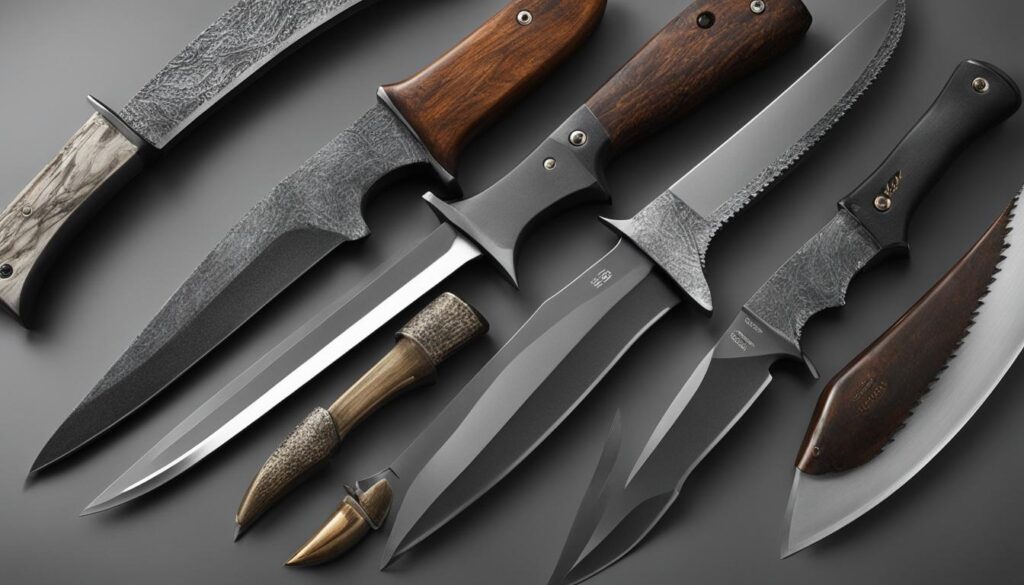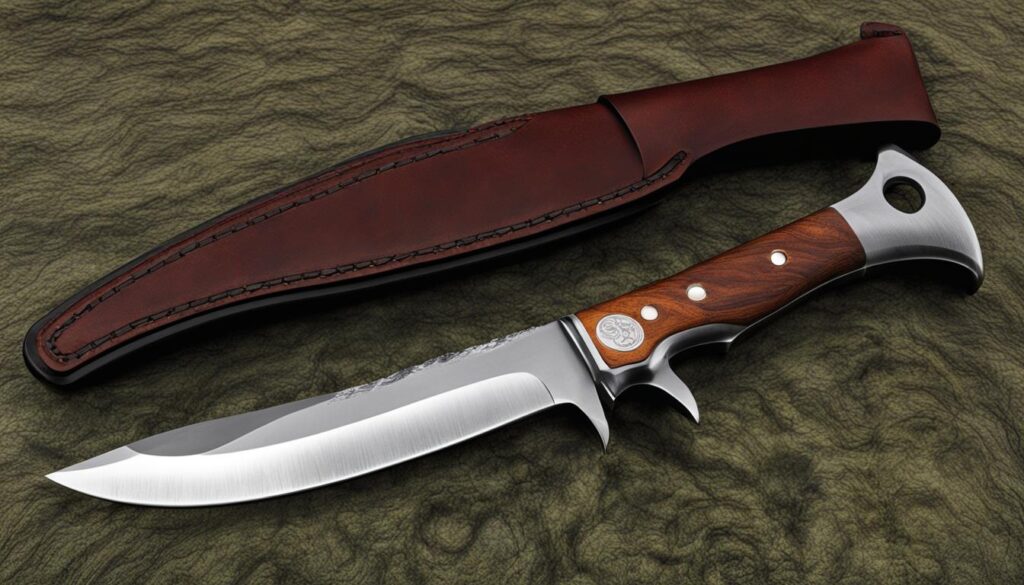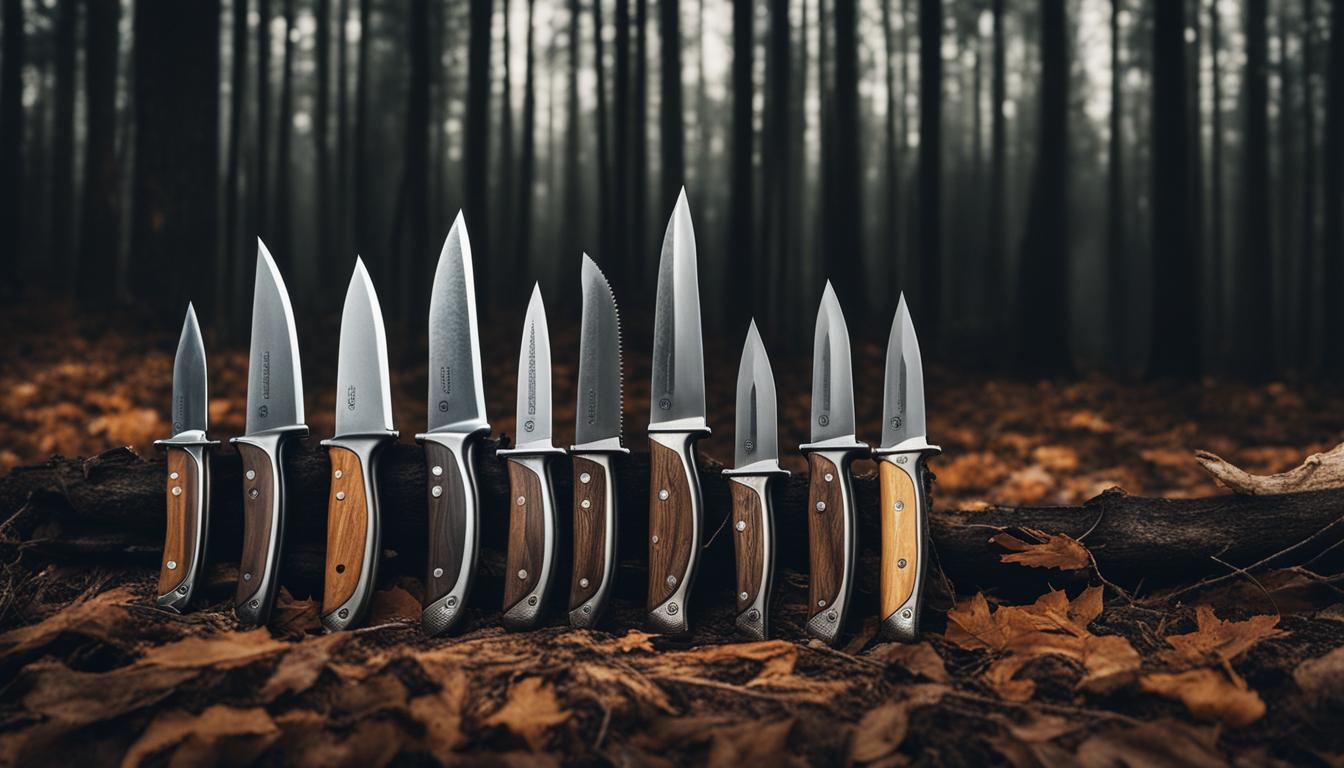When it comes to choosing a hunting knife, size matters. The blade length plays a crucial role in ensuring a successful hunting experience. But how do you know which size is right for you? In this guide, I will provide you with valuable insights and expert recommendations to help you pick the ideal knife length for your hunting needs.
According to experts, the ideal blade length for hunting whitetail deer falls between 3 to 4 inches. This length allows for easy dressing of the deer, making the process efficient and hassle-free. If you’re looking for a more versatile option that can handle various tasks in the field, a 4 inch blade is a solid choice. It strikes a balance between functionality and maneuverability.
When it comes to the knife’s construction, you have the option of choosing between fixed blade knives and folding knives. Fixed blade knives are generally stronger and easier to clean, while folding knives offer the convenience of easy storage and portability. Consider your preferences and the specific demands of your hunting trips before making a decision.
Some hunters prefer knives with gut hooks for field dressing purposes. While gut hooks can be convenient, they have their drawbacks. They can be challenging to sharpen and may occasionally clog. It’s essential to weigh the pros and cons before opting for a knife with a gut hook.
Finally, budget and personal preferences play a significant role in selecting the right hunting knife. Take your time to evaluate various options and choose a knife that feels comfortable in your hand and suits your specific needs.
Key Takeaways:
- Consider a blade length between 3 to 4 inches for hunting whitetail deer
- A 4 inch blade offers versatility for general-purpose hunting
- Fixed blade knives are stronger and easier to clean, while folding knives are more portable
- Gut hooks are a matter of personal preference and may have disadvantages
- Choose a hunting knife that fits your budget and personal preferences
The Best Hunting Knives: Top Recommendations
If you’re looking to purchase a new hunting knife, here are some top recommendations based on reviews and recommendations from experts.
Spyderco Bill Moran Drop Point Hunting Knife
The Spyderco Bill Moran Drop Point Hunting Knife features a 3.88-inch blade made of quality VG-10 steel and offers a comfortable grip. It is highly praised for its durability and versatility in various hunting tasks.
Buck Model 110 Hunter
The Buck Model 110 Hunter is a classic knife with a 3.75-inch blade and a lockback mechanism for secure use. It is admired for its time-tested design, reliability, and ease of use.
Fallkniven H1z
The Fallkniven H1z is a high-quality hunting knife with a 4-inch laminated VG-10 blade and a textured Thermorun handle for a firm grip. It is well-regarded for its exceptional sharpness, durability, and ergonomic design.
Gerber Gator Fixed Blade
The Gerber Gator Fixed Blade offers excellent value for money with its 4.02-inch 420HC blade, glass-filled nylon handle, and solid all-around performance. It is known for its ruggedness, reliability, and affordability.
CRKT Onion Skinner
The CRKT Onion Skinner, designed by renowned knifemaker Ken Onion, features a 3.75-inch Bohler K110 stainless steel blade and a unique handle design for improved grip. It is highly regarded for its exceptional edge retention, ease of sharpening, and ergonomics.
These knives are among the favorites among hunters and outdoor enthusiasts, offering a combination of quality, performance, and features necessary for successful hunting expeditions.
| Knife Model | Blade Length | Blade Material | Handle Material | Features |
|---|---|---|---|---|
| Spyderco Bill Moran Drop Point Hunting Knife | 3.88 inches | VG-10 steel | Ergonomic grip | Durable and versatile |
| Buck Model 110 Hunter | 3.75 inches | Stainless steel | Lockback mechanism | Time-tested design |
| Fallkniven H1z | 4 inches | Laminated VG-10 steel | Textured Thermorun | Exceptional sharpness and durability |
| Gerber Gator Fixed Blade | 4.02 inches | 420HC stainless steel | Glass-filled nylon | Rugged and affordable |
| CRKT Onion Skinner | 3.75 inches | Bohler K110 stainless steel | Unique handle design | Exceptional edge retention and ergonomics |
Understanding Steel Types for Hunting Knives
When it comes to choosing a hunting knife, one of the most important factors to consider is the type of steel used in the blade construction. The choice of steel can greatly impact the performance, durability, and overall quality of the knife. In this section, we will explore the different steel types commonly used in hunting knives and their characteristics.
Stainless Steel
Stainless steel is the most common type of steel used in hunting knives. It offers good corrosion resistance, making it ideal for outdoor use where the knife may come into contact with moisture. The industry benchmark for stainless steel in hunting knives is 440C, which provides a good balance of hardness, edge retention, and corrosion resistance. For even better performance, knives made with VG-10 stainless steel offer enhanced edge retention and corrosion resistance.
Carbon Steel
Carbon steel is another popular choice for hunting knives. While it is less corrosion-resistant than stainless steel, carbon steel can be hardened to higher levels without compromising strength. Common carbon steels used in knife-making include O1, A2, and D2. These steels offer better impact absorption and longer-lasting edge retention compared to stainless steel. However, they require proper maintenance to prevent rust and corrosion.
| Steel Type | Advantages | Disadvantages |
|---|---|---|
| Stainless Steel (440C) | Good corrosion resistance Durable and easy to maintain Offers a balance of hardness and edge retention |
May not hold an edge as long as other steels More prone to chipping or breaking under heavy use |
| Stainless Steel (VG-10) | Excellent edge retention High corrosion resistance Easy to sharpen |
Can be more expensive than other stainless steels May be more brittle and prone to chipping |
| Carbon Steel (O1, A2, D2) | Better impact absorption Longer-lasting edge retention Can be hardened to higher levels |
Less corrosion-resistant than stainless steel Requires proper maintenance to prevent rust |
When considering the best steel type for your hunting knife, it’s important to weigh the advantages and disadvantages of each steel type based on your specific needs and preferences. Stainless steel offers good corrosion resistance and ease of maintenance, while carbon steel provides better edge retention and durability. Ultimately, the choice comes down to personal preference, intended use, and the level of maintenance you’re willing to undertake.

Key Takeaways:
- Stainless steel is the most common type of steel used in hunting knives, offering good corrosion resistance and durability.
- 440C stainless steel is an industry benchmark for hunting knives, while VG-10 stainless steel provides enhanced edge retention and corrosion resistance.
- Carbon steel offers better impact absorption and longer-lasting edge retention, but requires proper maintenance to prevent rust.
- The choice between stainless steel and carbon steel depends on factors such as corrosion resistance, edge retention, and personal preferences.
Blade Shape and Length: Factors to Consider
When it comes to choosing a hunting knife, the blade shape and length are important factors to consider. The right blade shape can greatly impact the knife’s functionality and versatility in the field. The most common blade shape for hunting knives is the drop-point blade. Its curved spine and gradual, sloping point make it ideal for gutting and skinning game while still maintaining practicality for other tasks. The drop-point blade offers a good balance between strength and precision, making it suitable for a variety of hunting activities.
Another popular blade shape is the clip-point blade. This blade style features a concave curve towards the tip, creating a sharp, narrow point. While the clip-point blade is versatile and well-suited for general-purpose use, it may sacrifice some strength compared to a drop-point blade. Hunters who prioritize precision and control may prefer a skinner blade. This specialized blade shape is designed specifically for gutting and skinning game, offering more tip control and a sharper radius for precise cuts.
When it comes to blade length, it’s important to find a balance between functionality and manageability. A blade length of around 4 inches or less is generally recommended for hunting knives. Longer blades may be unwieldy and increase the risk of cutting too deep, while shorter blades may limit your ability to perform certain tasks. The ideal blade length will depend on the specific tasks you’ll be performing with the knife, as well as your own personal preferences.
| Blade Shape | Functionality | Best Use |
|---|---|---|
| Drop-point | Versatile, ideal for gutting and skinning | General hunting tasks |
| Clip-point | Sharp, precise, but may sacrifice some strength | General-purpose hunting |
| Skinner | Designed for gutting and skinning, offers more tip control | Precision tasks |
It’s important to note that individual preferences may vary, and the best blade shape and length for you ultimately depends on your specific needs and hunting style. Take the time to consider the tasks you’ll be performing, the type of game you’ll be hunting, and the level of precision and control you desire. By choosing the right blade shape and length, you can ensure that your hunting knife is a valuable tool that enhances your outdoor experiences.
Choosing Knife Size: Small, Medium, or Large?
When it comes to selecting a hunting knife, the size of the blade plays a crucial role. The size you choose depends on your intended use and personal preferences. Let’s explore the different options available and their suitability for various tasks.
Small Hunting Knives
Small hunting knives are compact and perfect for detailed tasks such as carving, preparing food, and handling small or medium-sized game. These knives offer exceptional maneuverability and are easy to carry, fitting effortlessly into pockets or backpacks. Their portability makes them a popular choice among hikers and campers who require versatility without compromising on functionality.
Medium Hunting Knives
Medium-sized hunting knives strike a balance between portability and versatility. They are suitable for a wide range of outdoor activities, including hunting, fishing, and camping. These knives are often recommended for bushcraft activities as they can handle most outdoor tasks with ease. If you’re looking for a jack-of-all-trades knife that can handle various tasks in the field, a medium-sized hunting knife is a reliable option.
Large Hunting Knives
Large hunting knives are designed for demanding outdoor tasks that require extra length and strength. They excel at chopping wood, setting up camp, and removing dense vegetation. If you’re planning on tackling heavy-duty tasks during your hunting trip, a large hunting knife is the ideal choice. However, keep in mind that large knives may be less suitable for detailed work like skinning or carving.
Ultimately, the decision on knife size comes down to your specific needs and intended use. Consider the tasks you’ll be performing, the game you’ll be hunting, and your personal preferences. By selecting the right size knife, you can enhance your outdoor adventures and ensure you have a reliable tool by your side.


“The size of a hunting knife depends on the intended use and personal preference.”
Conclusion
In conclusion, choosing the right hunting knife is crucial for a successful outdoor adventure. Consider the blade size, shape, and steel type as well as your personal preferences. The ideal blade size depends on the game you’ll be hunting and the tasks you’ll be performing. Whether you opt for a fixed blade or folding knife, weigh the pros and cons and select the one that suits your needs best. Remember, gut hooks are a matter of personal preference and may offer convenience for field dressing.
Ultimately, the best hunting knife is the one that feels comfortable in your hand and meets your specific requirements in the field. Take into account the recommendations and information provided in this guide to make an informed decision. Whether you’re carving, skinning, preparing food, or engaging in demanding outdoor tasks, the right hunting knife will be your trusted companion. Happy hunting!
Summary:
In summary, selecting the ideal hunting knife involves considering factors such as blade size, shape, and steel type. Small knives are perfect for detailed tasks, medium-sized knives offer versatility, and large knives are suitable for demanding outdoor tasks. Fixed blades are stronger and easier to clean, while folding knives offer portability. The choice between stainless steel and carbon steel depends on personal preference. Remember, the best hunting knife is the one that feels comfortable in your hand and suits your needs in the field. Keep these factors in mind to find the perfect hunting knife for your outdoor adventures.
Final Thoughts:
Finally, remember that a hunting knife is an essential tool for any outdoor enthusiast. It’s not just a tool for dressing game but also for various tasks in the field. The right hunting knife can make a world of difference in your outdoor experience. So take your time, do your research, and choose wisely. With the right hunting knife by your side, you’ll be well-prepared for any adventure that comes your way.
FAQ
What is the ideal blade length for hunting whitetail deer?
For hunting whitetail deer, a blade length between 3 to 4 inches is recommended.
Are fixed blade knives better than folding knives for hunting?
Fixed blade knives are generally stronger and easier to clean, while folding knives offer convenience in storage and portability.
Should I choose a hunting knife with a gut hook?
Whether to choose a knife with a gut hook is a matter of personal preference. Gut hooks offer convenience for field dressing but may have disadvantages like difficulty in sharpening and occasional clogging.
What are some recommended hunting knives?
Some top recommendations include the Spyderco Bill Moran Drop Point Hunting Knife, the Buck Model 110 Hunter, the Fallkniven H1z, the Gerber Gator Fixed Blade, and the CRKT Onion Skinner.
What are the different types of steel used in blade construction?
Stainless steel is the most common, with 440C, VG-10, 154CM, and ATS-34 being recommended options. Carbon steel is also used, with O1, A2, and D2 being common choices.
What are the different blade shapes for hunting knives?
The most common blade shapes for hunting knives are drop-point, clip-point, skinner, and gut hook.
What size of hunting knife should I choose?
The size of a hunting knife depends on personal preference and intended use. Small knives are compact, medium-sized knives offer a balance between portability and versatility, and large knives are ideal for demanding tasks.
How do I make the best choice when selecting a hunting knife?
Consider factors such as blade size, shape, steel type, and personal preferences. The best hunting knife is one that feels comfortable in your hand and suits your needs in the field.





